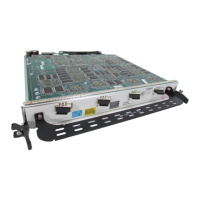Implementing Multicast Routing on Cisco IOS XR Software Cisco ASR 9000 Series Routers
Information About Implementing Multicast Routing
MCC-17
Multicast Configuration Guide
OL-
Source MVRF—An MVRF that can reach the source through a directly connected customer edge (CE)
router.
Receiver MVRF—An MVRF to which receivers are connected through one or more CE devices.
Source PE—A PE router that has a multicast source behind a directly connected CE router.
Receiver PE—A PE router that has one or more interested receivers behind a directly connected CE
router.
Information About the Extranet MVPN Routing Topology
In unicast routing of peer-to-peer VPNs, BGP routing protocol is used to advertise VPN IPv4 and IPv6
customer routes between provider edge (PE) routers. However, in an MVPN extranet peer-to-peer
network, PIM RPF is used to determine whether the RPF next hop is in the same or a different VRF and
whether that source VRF is local or remote to the PE.
Source MVRF on a Receiver PE Router
To provide extranet MVPN services to enterprise VPN customers by configuring a source MVRF on a
receiver PE router, you would complete the following procedure:
• On a receiver PE router that has one or more interested receivers in an extranet site behind a directly
connected CE router, configure an MVRF that has the same default MDT group as the site connected
to the multicast source.
• On the receiver PE router, configure the same unicast routing policy to import routes from the source
MVRF to the receiver MVRF.
If the originating MVRF of the RPF next hop is local (source MVRF at receiver PE router), the join state
of the receiver VRFs propagates over the core by using the default multicast distribution tree (MDT) of
the source VRF.
Figure 7 illustrates the flow of multicast traffic in an extranet MVPN topology where
the source MVRF is configured on a receiver PE router (source at receiver MVRF topology). An MVRF
is configured for VPN-A and VPN-B on PE2, a receiver PE router. A multicast source behind PE1, the
source PE router, is sending out a multicast stream to the MVRF for VPN-A, and there are interested
receivers behind PE2, the receiver PE router for VPN-B, and also behind PE3, the receiver PE router for
VPN-A. After PE1 receives the packets from the source in the MVRF for VPN-A, it replicates and
forwards the packets to PE2 and PE3. The packets received at PE2 in VPN-A are decapsulated and
replicated to receivers in VPN-B.

